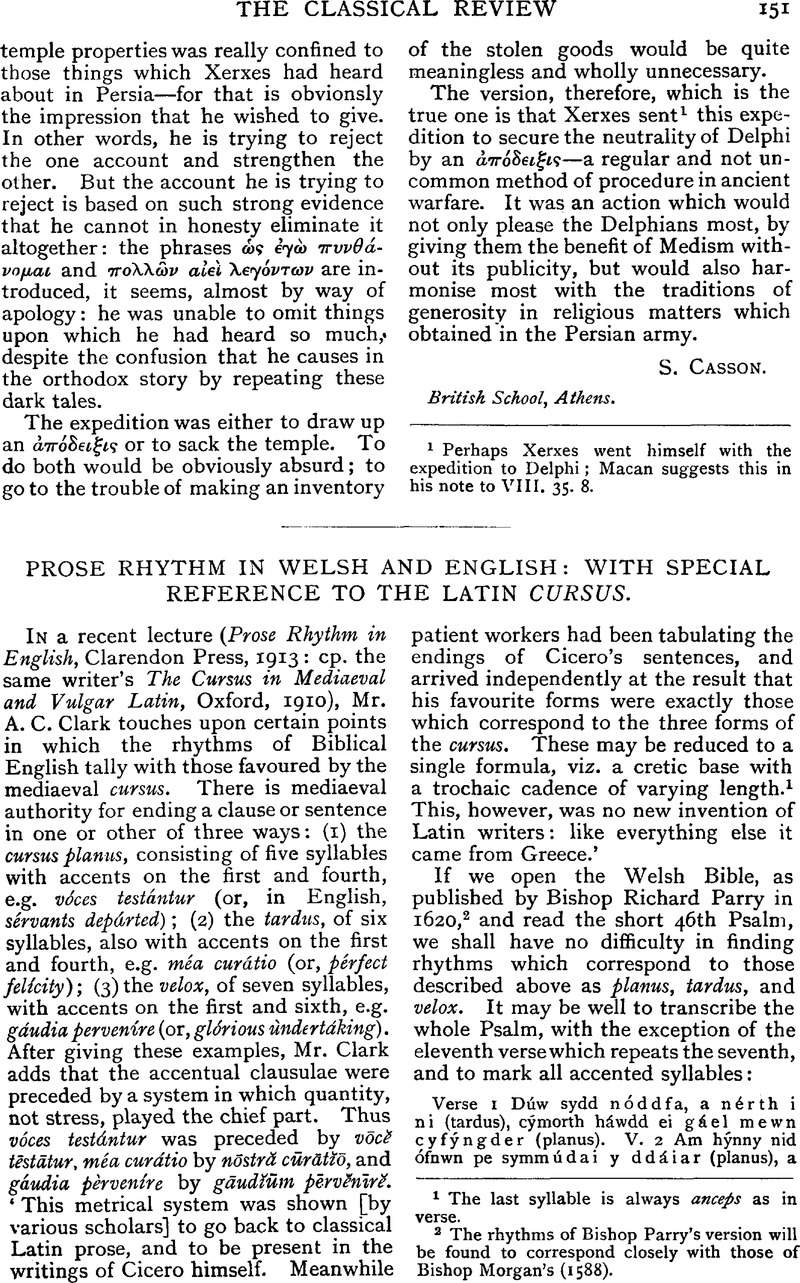No CrossRef data available.
Article contents
Prose Rhythm in Welsh and English: with Special Reference to the Latin Cursus
Published online by Cambridge University Press: 27 October 2009
Abstract

- Type
- Original Contributions
- Information
- Copyright
- Copyright © The Classical Association 1914
References
page 151 note 1 The last syllable is always anceps as in verse.
page 151 note 2 The rhythms of Bishop Parry's version will be found to correspond closely with those of Bishop Morgan's (1588).
page 152 note 1 o'i and a'i are monosyllables.
page 152 note 2 In the LXX one word in two or three is a monosyllable, the monosyllabic article in its various cases making much difference.
page 152 note 3 Cp. Welsh and English instances of planus (W. 9, E. 4) and tardus (W. 2, E. o) in Ps. xlvi.
page 153 note 1 With the exception of ‘redeemed’ (accented on the penultimate), all the words here are either disyllables (accented on the penultimate) or monosyllables (some of which are stressed). As already indicated, Welsh is still more prone to fall into trochaic rhythms because its polysyllables are, more commonly than in English (or in Latin), accented on the penultimate. It is, indeed, not too much to say that, in Welsh, the accent never falls before the penultimate except in a few modernisms not recognised in the stricter literary language. By a good reader, who respects the thought most of all and has regard to phrases (i.e., utterances made without pause) rather than to metrical feet, English prose will usually be saved from undue cadence. The passage of the Te Deum might well be read, ‘whòm-Thou-hast-redéémed with-Thy-précious blòod,’ the main stress being thrown on the central syllable of ‘redeemed.’ In the delivery of verse itself the thought is the best guide for the average reader, since, as Caesar said, si cantas, male cantas; si legis, cantas.
page 154 note 1 This assumes that Malory did not write ‘damosel.’
page 155 note 1 Y ddaiar, Morgan and Parry; 'r ddaear, Welsh Book of Common Prayer (Oxford, 1854).
page 155 note 2 Thrasymachus, one of the earliest writers on prose numbers, commended the paeon. The recurrence of the long syllables would be less marked in paeonic than in iambic, trochaic, or dactylic measures. At the end of the classical period, Aristotle also advocated the paeon for prose use. In any comparison of Latin rhythm with Greek, it must be remembered that the Latin language was undactylic, and that its dactylic poetry was developed late (not early, as in Greece) and by a tour de force. Even English can be more dactylic (in the accentual way) than Latin: compare such words as ‘felicity’ and ‘adversity’ with their Latin originals. A scrupulous writer, like Virgil, will not (I think) use patria as a dactyl, though it may help in forming the latter part of one. Again, such a word as filia presents in its oblique cases a problem which finds a spondaic solution in gnatae and the like. When accent took the place of quantity in Latin, the cursus could manufacture dactyls with terrible facility. It was easy for the cursus to employ accentually dactylic rhythms, as it had been for Cicero to avoid quantitatively dactylic rhythms.
page 155 note 3 In this, as in other ways, one sometimes feels that Cicero was more Italian than Roman. At all events, his tendency to uniform cadence was not countenanced by the more characteristic public oratory whether of Rome or Greece.


